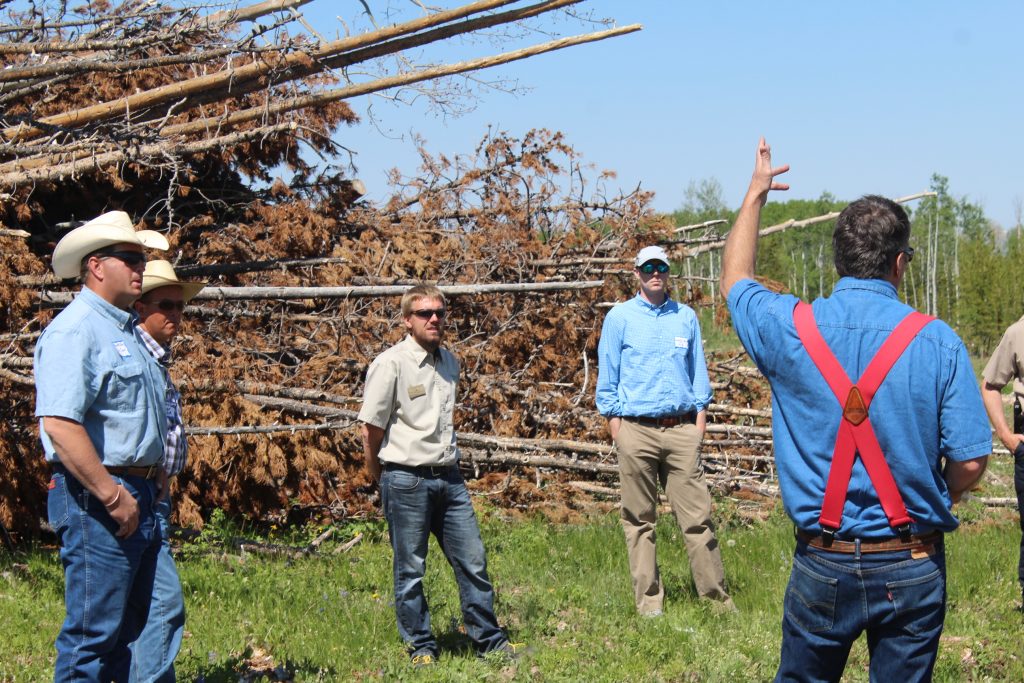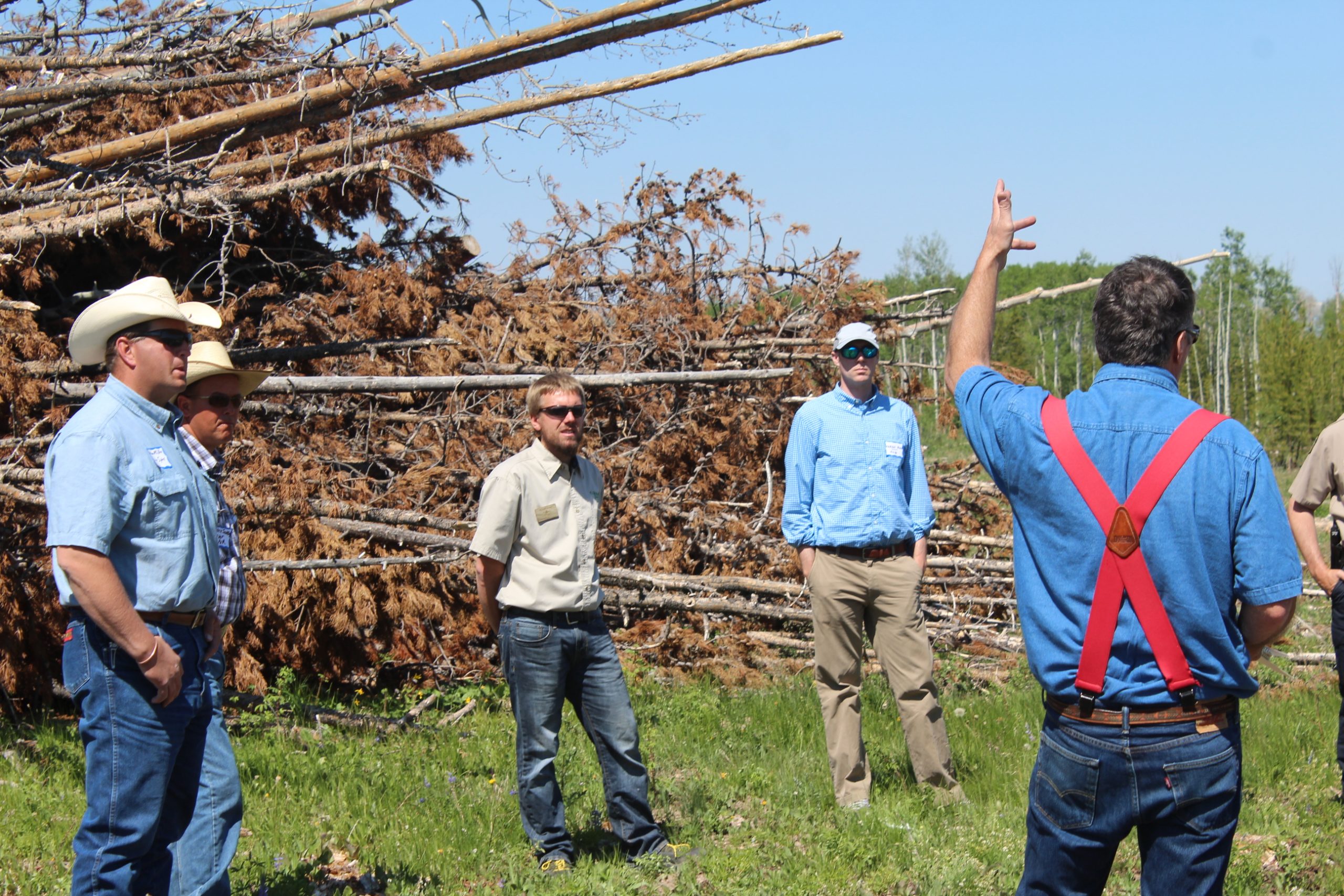WLA partners with Colorado State Forest Service in New Tour Series

On June 22nd, the Western Landowners Alliance (WLA) partnered with the Colorado State Land Board (SLB) and the Colorado State Forest Service (CSFS) for a Stewardship and Policy tour in the Colorado State Forest near Walden, CO, and area owned by the SLB, but managed by the CSFS. Participants numbered close to thirty and represented a diverse mixture of private and public entities including private ranches in Colorado and Wyoming, state and federal agencies, Colorado State University (CSU) Extension and nonprofit organizations.
 Like all WLA Stewardship and Policy tours, this gathering of landowners, managers and other practitioners provided an ideal setting for knowledge-sharing and peer networking. Bill Ryan, Director of the State Land Board began with a presentation on the history of the Land Board and then handed things over to John Twitchell, CSFS District Forester, who guided the group through a number of discussion topics at each of the six stops in the state forest. Tour topics ranged from the long-term effects of decades of fire suppression to current approaches in the aftermath of a devastating pine beetle epidemic, changing economics of timber harvesting, forest treatments including thinning and controlled burning, and management tools that may be transferable to private lands.
Like all WLA Stewardship and Policy tours, this gathering of landowners, managers and other practitioners provided an ideal setting for knowledge-sharing and peer networking. Bill Ryan, Director of the State Land Board began with a presentation on the history of the Land Board and then handed things over to John Twitchell, CSFS District Forester, who guided the group through a number of discussion topics at each of the six stops in the state forest. Tour topics ranged from the long-term effects of decades of fire suppression to current approaches in the aftermath of a devastating pine beetle epidemic, changing economics of timber harvesting, forest treatments including thinning and controlled burning, and management tools that may be transferable to private lands.
Inherent to each of these topics was the understanding that economics and ecological health must go hand-in-hand in order for each to thrive. The Colorado State Forest serves many uses, including timber harvesting, public recreation and private grazing. Twitchell and other forest managers take each of these uses into consideration when making important management decisions.
 For local ranchers, and in particular those who have grazing leases on the state forest lands, having a good working relationship with the CSFS makes a huge difference for their bottom line. Their good management, in turn, adds to the ecological health of the forest. For example, a lop and scatter approach to thinning is good for lodgepole pine in particular because more cones remain on the ground, leading to increased seedling germination, and the thick matt of vegetation left on the ground retains better moisture while protecting the emerging seedlings. However, that thick layer of slash makes it tough for cattle and horses to walk through a recently thinned area, as local rancher Jim Baller explained. Forest managers and ranchers were able to discuss both economic and ecological pros and cons for this and other management techniques, and identified several possible solutions that would still ensure both ecological and economic needs were met. Positive collaborative relationships across the public/private domains such as these help ensure a resilient community and a healthy landscape. As former rancher Perry Handyside expressed, “The solution is partnerships.”
For local ranchers, and in particular those who have grazing leases on the state forest lands, having a good working relationship with the CSFS makes a huge difference for their bottom line. Their good management, in turn, adds to the ecological health of the forest. For example, a lop and scatter approach to thinning is good for lodgepole pine in particular because more cones remain on the ground, leading to increased seedling germination, and the thick matt of vegetation left on the ground retains better moisture while protecting the emerging seedlings. However, that thick layer of slash makes it tough for cattle and horses to walk through a recently thinned area, as local rancher Jim Baller explained. Forest managers and ranchers were able to discuss both economic and ecological pros and cons for this and other management techniques, and identified several possible solutions that would still ensure both ecological and economic needs were met. Positive collaborative relationships across the public/private domains such as these help ensure a resilient community and a healthy landscape. As former rancher Perry Handyside expressed, “The solution is partnerships.”
 Another challenge affecting both ranchers and forest managers involves private fencelines that run through state- and federally-owned forest. Under the grazing lease agreements, the rancher is responsible for both the cost and labor of maintaining the fenceline. In the last several years following a devastating pine beetle epidemic, however, the cost of maintenance has drastically increased—both in terms of dollar amounts and the ranchers’ time. Beetle-kill trees can make up anywhere from 30 to 80 percent of a stand of trees—and those trees are starting to fall, causing extensive damage to fencelines underneath, at the rate of $12,000-14,000 per mile of fence. In the state forest, John Twitchell and other managers can act relatively quickly in circumstances such as this one. As he explains, “We’re a lot lighter on our feet” than federally-owned lands where well-intentioned but at-times imperfect bureaucratic policies like NEPA (National Environmental Policy Act) can additional delays in on-the-ground implementation of solutions. While this particular concern remains mostly a non-issue in the state forest, it still affects ranchers whose leases also include US Forest Service lands.
Another challenge affecting both ranchers and forest managers involves private fencelines that run through state- and federally-owned forest. Under the grazing lease agreements, the rancher is responsible for both the cost and labor of maintaining the fenceline. In the last several years following a devastating pine beetle epidemic, however, the cost of maintenance has drastically increased—both in terms of dollar amounts and the ranchers’ time. Beetle-kill trees can make up anywhere from 30 to 80 percent of a stand of trees—and those trees are starting to fall, causing extensive damage to fencelines underneath, at the rate of $12,000-14,000 per mile of fence. In the state forest, John Twitchell and other managers can act relatively quickly in circumstances such as this one. As he explains, “We’re a lot lighter on our feet” than federally-owned lands where well-intentioned but at-times imperfect bureaucratic policies like NEPA (National Environmental Policy Act) can additional delays in on-the-ground implementation of solutions. While this particular concern remains mostly a non-issue in the state forest, it still affects ranchers whose leases also include US Forest Service lands.
Perhaps less immediately tangible but just as important is the relationship between the state forest and the public, especially those among the public who recreate in the forest. Public perception and understanding—and ultimately approval—of forest management has substantial influence on what can actually be achieved on the ground.
 And it appears public acceptance for forest thinning has recently begun to increase. More frequent catastrophic wildfires throughout the West, created in part by decades of fire suppression and subsequent overgrowth, has brought regular attention to the complexities of good forest management—among them thinning and controlled burning, specifically to mitigate wildfires. What is still missing in the public dialogue, however, is the understanding that forest ecosystems vary widely across the West and require sometimes vastly different management techniques. For example, ponderosa pine forests of the southwest are more resilient to wildfire, drought and bark beetle following mechanical thinning. Given an appropriate level of density, ponderosa pine will survive a wildfire—and thrive because of it. Lodgepole pine, on the other hand “all grow up together and all go together,” as Twitchell explained.
And it appears public acceptance for forest thinning has recently begun to increase. More frequent catastrophic wildfires throughout the West, created in part by decades of fire suppression and subsequent overgrowth, has brought regular attention to the complexities of good forest management—among them thinning and controlled burning, specifically to mitigate wildfires. What is still missing in the public dialogue, however, is the understanding that forest ecosystems vary widely across the West and require sometimes vastly different management techniques. For example, ponderosa pine forests of the southwest are more resilient to wildfire, drought and bark beetle following mechanical thinning. Given an appropriate level of density, ponderosa pine will survive a wildfire—and thrive because of it. Lodgepole pine, on the other hand “all grow up together and all go together,” as Twitchell explained.
For example, because lodgepole pines are a shallow-rooted species, they rely on a high level of forest density to withstand high winds. If a lodgepole pine forest is simply thinned to a lesser density, the trees that are left will likely get blown down by the wind. Historically, lodgepole pine forests experienced stand-replacing fires that left a wide-open field where the serotinous cones—pine cones covered in a layer of resin and opened only by heat, either from fire or direct exposure to sun—would shed their seeds and bring about a new forest.
In order to avoid catastrophic wildfires, but still maintain healthy lodgepole forests, managers need to essentially clear-cut portions of the forest. This style of management is understandably not popular among the public, and has resulted in limiting what managers can do: “We were socially restrained on the scope of cuts,” noted Twitchell.
With continued public education campaigns, public understanding—and acceptance—is steadily increasing with regards to forest treatments like mechanical thinning and controlled burning. And, as treatments are implemented and as managers are given the opportunity to observe and learn from these treatments over subsequent years of regeneration, management is improving. Twitchell showed us treatments from as long ago as 1986 to as recently as last year, allowing tour participants to see the results of 8-10 inches of annual growth in a number of different treatment areas.
As Twitchell explained to the group, good forest management creates a diversity of age classes throughout the forest, thereby providing needed products to society while also ensuring a sustainable income to support ongoing management. “This is a long-term investment,” said Twitchell. In addition to creating more resilient, less fire-prone forests, well-implemented treatments result in an increase in ground water, which in turn helps ensure a healthier ecosystem.
The tour ended at the new Colorado State Forest Service facility, which was added to the National Registry of Historic Places in January of this year.
The tour was a combined effort between the Colorado State Land Board, Colorado State Forest Service and the Western Landowners Alliance whose core goal was to create an informative opportunity to bring landowners into the conversation about best forest management practices. WLA’s executive director, Lesli Allison, ended the tour by encouraging landowners to make their voices heard in the policy arena related to forest, range and riparian management.
Join WLA to stay up to date on the most important news and policy for land stewards.
Become a member for free today and we will send you the news and policy developments critical to the economic and ecological health of working lands.
WLA works on behalf of landowners and practitioners throughout the West. We will never share your contact information with anyone.
©2025 Western Landowners Alliance • PO BOX 27798, Denver, CO 80227 • 505.466.1495
Western Landowners Alliance is a 501 (c)(3) non-profit recognized by the IRS.
Tax ID: 46-1346488
